Related Research Articles
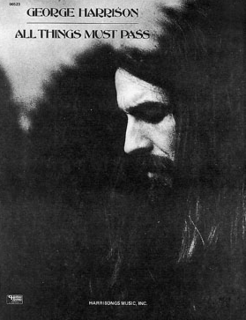
"All Things Must Pass" is a song by English musician George Harrison, issued in November 1970 as the title track to his triple album of the same name. Billy Preston released the song originally – as "All Things (Must) Pass" – on his Apple Records album Encouraging Words (1970), after the Beatles had rejected it for inclusion on their Let It Be album in January 1969. The composition reflects the influence of the Band's sound and communal music-making on Harrison, after he had spent time with the group in Woodstock, New York, in late 1968, while Timothy Leary's poem "All Things Pass", a psychedelic adaptation of the Tao Te Ching, provided inspiration for his song lyrics.
"Don't Let Me Wait Too Long" is a song by English rock musician George Harrison, released on his 1973 album Living in the Material World. It was scheduled to be issued as a single in September that year, as the follow-up to "Give Me Love ", but the release was cancelled. Music critics have traditionally viewed "Don't Let Me Wait Too Long" as a highlight of the Material World album, praising its pop qualities and production, with some considering the song worthy of hit status.
"The Lord Loves the One " is a song by English rock musician George Harrison, released on his 1973 album Living in the Material World. Like the album's title track, it was inspired by the teachings of A.C. Bhaktivedanta Swami Prabhupada, founder of the International Society for Krishna Consciousness (ISKCON), more commonly known as the Hare Krishna movement. The song is an uptempo rock track with elements of blues and gospel. Some commentators have described it as the musical highpoint of Living in the Material World, with Harrison's slide guitar playing singled out as being among the finest performances of his career.
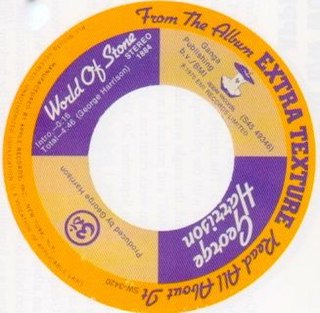
"World of Stone" is a song by English rock musician George Harrison, released in 1975 on Extra Texture , his final album for Apple Records. It was also issued as the B-side of the album's lead single, "You". Harrison wrote the song in 1973 but recorded it two years later, following the unfavourable critical reception afforded his 1974 North American tour with Ravi Shankar and the Dark Horse album. Due to its context on release, commentators view "World of Stone" as a plea from Harrison for tolerance from these detractors. According to some of his biographers, the lyrics reflect Harrison's doubts regarding his devotion to a spiritual path – an apparent crisis of faith that followed his often-unwelcome spiritual pronouncements during the tour, and which permeated his work throughout 1975.

"Teardrops" is a song by English rock musician George Harrison from his 1981 album Somewhere in England. It was also issued as the second single off the album, in July 1981. As with the lead single, "All Those Years Ago", Harrison completed the song after Warner Bros. Records had rejected his initial submission of Somewhere in England in September 1980. In response to Warner's concerns, he wrote "Teardrops" as an attempt at a commercially oriented song.
"That's the Way It Goes" is a song by English musician George Harrison from his 1982 album Gone Troppo. Harrison wrote the song during a period when he had become uninterested in contemporary music and was enjoying success as a film producer with his company HandMade Films. Partly influenced by his extended holidays in Hawaii and Australia, the lyrics convey his dismay at the world's preoccupation with money and status, although, unlike several of Harrison's previous musical statements on the subject, he expresses resignation and acceptance.

"Deep Blue" is a song by English rock musician George Harrison that was released as the B-side to his 1971 charity single "Bangla Desh". Harrison wrote the song in 1970, midway through the recording sessions for All Things Must Pass, and recorded it in Los Angeles the following year while organising the Concert for Bangladesh. The composition was inspired by the deteriorating condition of his mother, Louise, before she succumbed to cancer in July 1970, and by Harrison's feelings of helplessness as he visited her in hospital in the north of England. Given the subject matter, "Deep Blue" also served to convey the suffering endured by the millions of refugees from war-torn Bangladesh in 1971, as sickness and disease became widespread among their makeshift camps in northern India.

"Hari's on Tour (Express)" is an instrumental by English musician George Harrison, released as the opening track of his 1974 album Dark Horse. It was also the B-side of the album's second single – which was "Ding Dong, Ding Dong" in North America and most other territories, and "Dark Horse" in Britain and some European countries. Among Harrison's post-Beatles solo releases, the track is the first of only two genuine instrumentals he released from 1970 onwards – the other being the Grammy Award-winning "Marwa Blues", from his 2002 album Brainwashed.

"Māya Love" is a song by English musician George Harrison, released on his 1974 album Dark Horse. The song originated as a slide guitar tune, to which Harrison later added lyrics relating to the illusory nature of love – maya being a Sanskrit term for "illusion", or "that which is not". Harrison's biographers consider the lyrical theme to be reflective of his failed marriage to Pattie Boyd, who left him for his friend Eric Clapton shortly before the words were written. Harrison recorded the song at his home, Friar Park, on the eve of his North American tour with Ravi Shankar, which took place in November and December 1974. The recording features Harrison's slide guitar extensively and contributions from four musicians who formed the nucleus of his tour band: Billy Preston, Tom Scott, Willie Weeks and Andy Newmark. Reviewers note the track as an example of its parent album's more diverse musical genres, namely funk and rhythm and blues, compared with the more traditional rock orientation of Harrison's earlier solo work.
"Grey Cloudy Lies" is a song by English rock musician George Harrison from his 1975 album Extra Texture . Harrison wrote it in 1973 during a period that he characterised as his "naughty" years, coinciding with the failure of his marriage to Pattie Boyd and his divergence from the ascetic path of his Hindu-aligned faith. He returned to the song two years later when filled with despondency and self-doubt in response to the scathing reviews that his 1974 North American tour with Ravi Shankar and Dark Horse album had received from several music critics.

"Learning How to Love You" is a song by English musician George Harrison, released in 1976 as the closing track of his debut album on his Dark Horse record label, Thirty Three & 1/3. Harrison wrote the song for Herb Alpert, sometime singer and co-head of A&M Records, which at the time was the worldwide distributor for Dark Horse. Although the relationship with A&M soured due to Harrison's failure to deliver Thirty Three & 1/3 on schedule, resulting in litigation and a new distribution deal with Warner Bros. Records, Harrison still dedicated the song to Alpert in the album's liner notes.
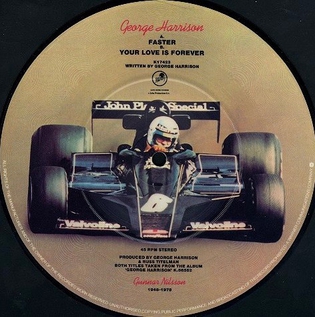
"Your Love Is Forever" is a song by English rock musician George Harrison from his 1979 album George Harrison. He wrote it as a guitar instrumental in an open tuning, before adding lyrics at the suggestion of his co-producer, Russ Titelman. The lyrics have an ambiguity typical of Harrison's work, in that the love he expresses is directed towards both a romantic partner and his God. In the United Kingdom, the song was also issued as the B-side of "Faster", on a charity single benefiting the cancer research project set up by the late Formula 1 driver Gunnar Nilsson.

"Soft Touch" is a song by English rock musician George Harrison from his 1979 album George Harrison. It was also issued as the B-side of the album's lead single, "Blow Away", in Britain and some other countries, while in markets such as North America, it was the B-side of the second single, "Love Comes to Everyone". Harrison wrote the song while in the Virgin Islands with his future wife, Olivia Arias, shortly before recording his 1976 album Thirty Three & ⅓. The song is a love song in which Harrison also conveys his wonder at the idyllic island setting.
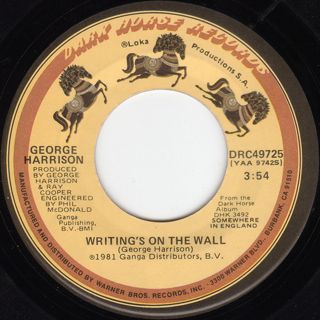
"Writing's on the Wall" is a song by English musician George Harrison from his 1981 album Somewhere in England. It was also the B-side of the album's lead single, "All Those Years Ago", which Harrison wrote as a tribute to his former Beatles bandmate John Lennon. In his lyrics, Harrison sings of the transient nature of life and the importance of recognising a spiritual purpose. Although the song was written long before Lennon's murder in New York in December 1980, the lyrics' reference to how easily friends can be shot down and killed led listeners to interpret it as a further comment on Lennon's death.

"Save the World" is a song by English musician George Harrison, released as the final track of his 1981 album Somewhere in England. It was also the B-side of "Teardrops", which was the second single off the album. An environmental protest song, "Save the World" was Harrison's first composition to directly address topical issues such as the nuclear arms race, rainforest and wildlife devastation, and the ecologically irresponsible practices of corporate concerns. Musically, the song partly recalls the style of the comedy troupe Monty Python.
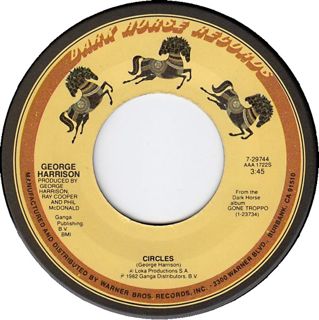
"Circles" is a song by English rock musician George Harrison, released as the final track of his 1982 album Gone Troppo. Harrison wrote the song in India in 1968 while he and the Beatles were studying Transcendental Meditation with Maharishi Mahesh Yogi. The theme of the lyrics is reincarnation. The composition reflects the cyclical aspect of human existence as, according to Hindu doctrine, the soul continues to pass from one life to the next. Although the Beatles never formally recorded it, "Circles" was among the demos the group made at Harrison's Esher home, Kinfauns, in May 1968, while considering material for their double album The Beatles.
"Heading for the Light" is a song by the British–American supergroup the Traveling Wilburys from their 1988 album Traveling Wilburys Vol. 1. It was written primarily by George Harrison but credited to all five members of the band. Harrison sings the song with Jeff Lynne, who also co-produced the track and, with Harrison, formulated the idea for starting the Wilburys. The song was issued as a promotional single in the United States, where it peaked at number 7 on Billboard's Album Rock Tracks chart. The song received a commercial release in Australia in 1989, where it peaked at number 88 on the ARIA singles chart.
"Ride Rajbun" is a song by English musician George Harrison. It was released in 1992 on the multi-artist charity album The Bunbury Tails, which was the soundtrack to the British animated television series of the same name. Harrison co-wrote the song's lyrics with Bunbury Tails creator David English. The eponymous Rajbun was a character in the series, one of a team of cricket-playing rabbits – in this case, from Bangalore in India. The composition is in the style of a nursery rhyme or children's song, while the all-Indian instrumentation on the recording recalls some of Harrison's compositions for the Beatles during 1966–68.

Songs by George Harrison is a book of song lyrics and commentary by English musician George Harrison, with illustrations by New Zealand artist Keith West. It was published in February 1988, in a limited run of 2500 copies, by Genesis Publications, and included an EP of rare or previously unreleased Harrison recordings. Intended as a luxury item, each copy was hand-bound and boxed, and available only by direct order through Genesis in England. The book contains the lyrics to 60 Harrison compositions, the themes of which West represents visually with watercolour paintings. Starting in 1985, Harrison and West worked on the project for two years, during which Harrison returned to music-making with his album Cloud Nine, after focusing on film production for much of the early 1980s. The book includes a foreword by his Cloud Nine co-producer, Jeff Lynne, and a written contribution from Elton John.
Songs by George Harrison 2 is a book of song lyrics and commentary by English musician George Harrison, with illustrations by Keith West and an accompanying EP of previously unreleased Harrison recordings. It was published in June 1992, in a limited run of 2500 copies, by Genesis Publications. As with Harrison and West's first volume, published in 1988, each copy was hand-bound and available only by direct order through Genesis in England.
References
- 1 2 3 4 5 6 7 8 Madinger & Easter, p. 459.
- ↑ Madinger & Easter, p. 457.
- ↑ Lavezzoli, pp. 196–97.
- ↑ Tillery, pp. 114–15.
- ↑ The Editors of Rolling Stone, pp. 44, 140.
- ↑ Allison, pp. 46, 48.
- 1 2 3 Huntley, p. 180.
- ↑ Harry, p. 212.
- ↑ Doggett, p. 262.
- ↑ Tillery, p. 120.
- ↑ Huntley, p. 159.
- ↑ Rodriguez, pp. 386, 433.
- ↑ Snow, p. 69.
- 1 2 3 4 Inglis, p. 75.
- 1 2 Leng, pp. 219–20.
- ↑ Heylin, pp. 528–29.
- ↑ Leng, p. 119.
- ↑ Allison, p. 148.
- ↑ Allison, pp. 48, 55.
- ↑ Tillery, p. 154.
- ↑ Allison, p. 88.
- 1 2 3 Clayson, p. 380.
- ↑ Allison, pp. 148–49.
- ↑ Allison, pp. 18, 88, 148.
- ↑ Allison, pp. 55, 148-49.
- ↑ Somewhere in England CD booklet (Dark Horse Records, 2004; produced by George Harrison & Ray Cooper), p. 5.
- ↑ Huntley, p. 244.
- ↑ Inglis, p. 103.
- 1 2 3 4 Leng, p. 220.
- 1 2 Badman, p. 263.
- ↑ Inglis, p. 72.
- ↑ Badman, p. 266.
- ↑ Inglis, pp. 150–51.
- ↑ Heylin, pp. 506–07.
- ↑ Sounes, pp. 329–31, 342.
- 1 2 Madinger & Easter, p. 460.
- ↑ Doggett, p. 267.
- ↑ Clayson, pp. 377–78.
- ↑ Rodriguez, p. 433.
- ↑ Snow, pp. 68, 69.
- ↑ Leng, p. 213.
- ↑ Kooper, pp. 230, 232.
- ↑ Harry, p. 349.
- ↑ Badman, p. 284.
- ↑ Tillery, p. 164.
- ↑ Harry, pp. 349–50.
- ↑ Leng, p. 222.
- Heylin, p. 542.
- Sounes, pp. 348–49, 351.
- Kooper, p. 238.
- ↑ Inglis, p. 78.
- ↑ Ingham, pp. 129, 136.
- ↑ Larkin, pp. 2646–47.
- ↑ Leng, pp. 217–18.
- ↑ Madinger & Easter, pp. 459–60.
- 1 2 Harry Thomas, "George Harrison: Somewhere In England", Rolling Stone , 6 August 1981, p. 44 (archived version from 24 November 2007, retrieved 19 November 2016).
- ↑ Huntley, p. 183.
- ↑ Leng, p. 177.
- ↑ "Picks and Pans Review: Somewhere in England", People , 27 July 1981 (archived version from 27 December 2013, retrieved 19 November 2016).
- ↑ Mitchell Cohen, "George Harrison: Somewhere In England", Creem , September 1981; available at Rock's Backpages (subscription required).
- ↑ Woffinden, p. 107.
- ↑ Harry, p. 28.
- ↑ Allison, p. 149.
- ↑ Madinger & Easter, pp. 459, 638.
- ↑ Leng, p. 326.
- ↑ Badman, pp. 588, 589.
- ↑ Huntley, pp. 278–79.
- ↑ Huntley, p. 279.
- Kahn, p. 511.
- ↑ Rip Rense, ""There Went the Sun: Reflection on the Passing of George Harrison", Beatlefan, 29 January 2002 (retrieved 24 November 2016).
- ↑ John Metzger, "George Harrison The Dark Horse Years (Part Three: Somewhere in England)", The Music Box, vol. 11 (5), May 2004 (retrieved 20 November 2016).
- ↑ Paul Du Noyer, "Back Catalogue: George Harrison", Blender , April 2004, pp. 152–53.
- ↑ James Griffiths, "George Harrison: The Dark Horse Years Deluxe Box Set", The Guardian , 19 March 2004 (retrieved 24 November 2016).
- ↑ Leng, p. 320.
- ↑ Inglis, p. 141.